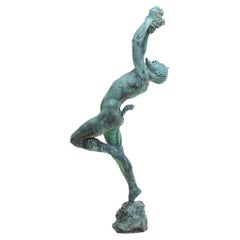Furniture
1
to
1
1
1
1
1
1
1
1
1
1
5,206
4,014
2,460
2,235
Creator: Severo Calzetta da Ravenna
Calzetta Da Ravenna Severo Candlestick Depicting a Kneeling Satyr
By Severo Calzetta da Ravenna
Located in Milano, IT
Calzetta Da Ravenna (Attivo Tra IL 1496 E IL 1543 circa) Severo. Circle of. Candlestick depicting a kneeling satyr.
The model of the present bronze is the ""kneeling satyr"" attributed to Severo Calzetta da Ravenna, one of the main Paduan bronze sculptors of the first half of the 16th century, whose figure was rediscovered by Planiscig in 1935 (L. Planiscig, ""Severo da Ravenna...
Category
16th Century Italian Renaissance Antique Furniture
Materials
Bronze
Related Items
Satyr as Bacchant, Copper Sculpture, dated 1928
Located in Greding, DE
Large patinated copper sculpture of a naked dancing satyr in dynamic posture balancing on a small landscape base. He holds a vine over his face with both outstretched fists and bends...
Category
1920s Vintage Furniture
Materials
Copper
Asian Gilt Bronze Teppanom Kneeling Thai Sacred Angels
Located in North Hollywood, CA
Two Asian gilt bronze Teppanom kneeling Thai sacred angels.
Bronze gilded temple guardians in a sitting position. These temple guardians were made in Th...
Category
Mid-20th Century Thai Folk Art Furniture
Materials
Bronze
Bronze Sculpture Representing a Kneeling Woman
Located in Montreal, QC
Bronze sculpture representing a kneeling woman melted in Montreal by foundry "Fonderie d'Art Vandevoorde".
Category
1970s Canadian Vintage Furniture
Materials
Bronze
Niccolò da Uzzano Bust
By Raffaello Romanelli
Located in Milan, IT
A stupendous reproduction of the Niccolò da Uzzano Bust by Donatello (1432) preserved at the Bargello Museum of Florence, this extraordinary oeuvre is one of the most ancient busts...
Category
2010s Italian Furniture
Materials
Plaster
Cercle of Jacopo della Pila - Marble relief depicting a winged Cherub
Located in Bruxelles, BE
Cercle of Jacopo della Pila (Lombard, in Naples 1471-1502)
Marble relief depicting a winged Cherub
Naples, second half of15th century
40 x 57 x 12 cm
Exquisitely carved, this relief portrays a winged cherub with cascading hair and delicate features. The cherub's plump, smooth countenance, rounded cheeks, outlined lips, and finely drawn nose emanate a sense of tenderness. The quadrangular module, is adorned with a carved frame. The relief ascends gradually, transitioning from the low relief of the wings to the high relief of the head.
The rectangular frame and the subtly curved form of the artwork suggest that the relief likely adorned the upper part of an arch or a vaulted chapel. The type is that of the perspective room with a coffered ceiling decorated with figures of winged cherubs, which is found in various Neapolitan chapels of the 15th century. Coffered ceilings attest to the recovery of antiquity and the search for luxury in Renaissance architecture, first in Florence, then in Rome and Naples. The majority of the numerous family chapels and tombs built during the late fifteenth century in south of Italy employ the new formal vocabulary of the Florentine Renaissance in a self-confident manner that permitted a broad spectrum of variations.
The escalating admiration for the classical world, coupled with the development of perspective, significantly contributed to the Renaissance endorsement of coffered ceilings. This artistic and constructive device drew inspiration from the intricate marble patterns observed in historical landmarks such as the Arch of Titus, the Temple of Vesta in Tivoli, the Pantheon, and the Basilica of Maxentius. A distilled product of both mathematical and artistic cultures, deeply scrutinizing the ancient world, the coffered ceiling plays a vital role in the perspective construction of space with its regular and directional geometry. The motif of the coffered ceiling decorated with cherubs in relief was introduced in Naples by Francesco Laurana in the plastic decoration of the Arch of Castelnuovo. Laurana's impact on the art scene in the south of Italy was profound. The introduction of the winged cherub into the region's artistic vocabulary bridged the gap between the classical and the contemporary, creating a synthesis that resonated with both aesthetic and spiritual sensibilities. His influence extended beyond the immediate visual appeal, shaping the cultural identity of the Renaissance in southern Italy. Although the plastic decoration of the Arch of Castelnuovo cannot certainly be ascribed to a mature Renaissance style, it was precisely on this occasion that the sculptors who worked there could get to know and export throughout the Italian peninsula that type of "Florentine classicism" which, even in the 15th century Naples, was conditioned by the Burgundian culture imported into the Kingdom by Alfonso of Aragon himself, with artists called from Spain and Northern Europe. The coffered ceiling, with its geometric patterns and Laurana's winged cherubs nestled within, became a symbol of refinement and cultural sophistication. The relief sculptures, carefully integrated into the overall design, transformed the ceiling into a celestial realm, inviting viewers to contemplate the divine while immersed in the grandeur of the Renaissance space.
Similar winged cherubs appears also in the Naples cathedral. Within the renowned Succorpo Chapel, a mesmerizing marble coffered ceiling adorned with cherubs epitomizes the splendor of the Neapolitan Renaissance. The interplay of light and shadow on the textured surface of the marble coffered ceiling introduces an ethereal dimension, providing an immersive visual experience for observers. The geometric precision and the repeated patterns, reminiscent of classical motifs, establish a sense of harmony and balance that has become the hallmark of the Neapolitan interpretation of Florentine Renaissance aesthetics.
Although probably intended to be admired from a distance, this cherub is intricately detailed and exquisitely rendered: the face and hair are elegantly outlined and the feathers are textured through juxtaposed lines. The marble, both figurative and decorative, adheres to the principles of balance and restrained ornamentation typical of the « Florentine Classicism ». Harmonious shapes and gracefully orchestrated curves , rooted in the classical repertoire, converge to evoke a sense of ethereal beauty. The surface displays the masterful use of a chisel to intricately carve the feathers and facial features, creating an almost abstract quality.
This work is a testament to a sculptor of great skill and rich figurative knowledge, seamlessly blending classical firmness in contours with a refined treatment of the marble's surface. The combination of tradition and innovation point to a stylistic idiom from Lombardy, in particular we can find some comparaisons with the works of Jacopo della Pila, sculptor of Lombard origin working in Naples in the second half of the 15th century. He is documented there between 1471 and 1502, and is a protagonist of the Aragon Renaissance in the second half of the Quattrocento, together with the other great Northern sculptor active in the kingdom, Domenico Gagini.
the first commission he received dates back to August 9, 1471, when Jacopo publicly committed to sculpting the funerary monument of Archbishop Nicola Piscicelli to be placed in the Cathedral of Salerno. The last known work is an altar ordered on July 29, 1502, by the noble Jacopo Rocco for the church of San Lorenzo Maggiore in Naples. Between these two chronological extremes (1471-1502), we must place the fervent activity of the artist, who had trained in Rome, perhaps under the guidance of Paolo Romano but also engaged in dialogue with other major artists of the city, especially Isaia da Pisa. He enriched his experience in Naples, initially drawing inspiration from the works of Domenico Gagini and later from the Tuscan masterpieces of Antonio Rossellino and Benedetto da Maiano destined for the church of Santa Maria di Monteoliveto. Jacopo della Pila's artistic personality is thus based on a complex interplay of influences, contributing to the definition of a highly personal style.
Close comparaison can be made between our cherub and the winged angels reliefs...
Category
15th Century and Earlier Italian Renaissance Antique Furniture
Materials
Marble
H 15.75 in W 22.45 in D 4.73 in
Dionysus On The Shoulders Of A Satyr
Located in Honnelles, WHT
Dionysus on the shoulders of a satyr, bronze after the antique on a yellow base from Siena marble,
19th century
Category
19th Century Italian Greco Roman Antique Furniture
Materials
Marble, Bronze
French Terracotta Bust of a Satyr
Located in Stamford, CT
A French terracotta bust of a Satyr on matching socle circa 1810.
Category
19th Century French Classical Greek Antique Furniture
Materials
Terracotta
Jalisco Kneeling Female Figure, ca. 400 AD
Located in Chicago, IL
This commanding earthenware figure is attributed to the Jalisco region of Western Mexico and dates to ca. 400 AD. Possibly depicting an ancestor, warrior, or mythical person, the fig...
Category
15th Century and Earlier Mexican Pre-Columbian Antique Furniture
Materials
Earthenware
French Bronze, Satyr and Virgin
Located in Winter Park, FL
A bronze patinated French sculpture of a satyr and a virgin, unsigned. Please refer to photos for more details. We have a large selection of French antiques at Olivier Fleury...
Category
19th Century French Antique Furniture
Materials
Bronze
Marble Sculpture of Satyr
Located in New Haven, CT
Masterfully executed marble sculpture of Marsyas with lover.
French after the Greek Antique
Ca 1780
Category
1780s French Classical Greek Antique Furniture
Materials
Marble
1970s Style Erotic Chromed Bronze Kneeling Nude Statue
Located in Van Nuys, CA
1970s style erotic bronze re-cast of a kneeling nude woman with one hand resting against her wind blown hair, one hand on her leg. Kneeling on a black mirror-finished marble square b...
Category
21st Century and Contemporary American Post-Modern Furniture
Materials
Marble, Bronze, Chrome
Wood Low-Relief Depicting a Werewolf and Saint George
Located in Saint-Ouen, FR
Exceptional polychrome wood low-relief depicting a werewolf and saint george after a woodcut by lucas cranach (“DER WERWOLF” 1512)
Provenance :
collection Brimo de Laroussihle
c...
Category
16th Century German Renaissance Antique Furniture
Materials
Wood
Severo Calzetta Da Ravenna furniture for sale on 1stDibs.
Severo Calzetta da Ravenna furniture are available for sale on 1stDibs. These distinctive items are frequently made of metal and are designed with extraordinary care. If you’re looking for additional options, many customers also consider furniture by Ferdinando Vichi, and Carlo Ginori. Prices for Severo Calzetta da Ravenna furniture can differ depending upon size, time period and other attributes — on 1stDibs, these items begin at $16,643 and can go as high as $16,643, while a piece like these, on average, fetch $16,643.


